Inside\Within is a constantly updating web archive devoted to physically exploring the creative spaces of Chicago's emerging and established artists.
Support for this project was provided by The Propeller Fund, a joint administrated grant from Threewalls and Gallery 400 at The University of Illinois at Chicago.

Search using the field below:
Or display posts from these tags:
3D printing 3D scanning 65 Grand 7/3 Split 8550 Ohio 96 ACRES A+D Gallery ACRE animation Art Institute of Chicago Arts Incubator Arts of Life audio blogging Brain Frame CAKE Carrie Secrist Gallery casting ceramics Chicago Artist Writers Chicago Artists Coalition Chicago Cultural Center Cleve Carney Art Gallery Clutch Gallery Cobalt Studio Coco River Fudge Street collage collection Columbia College Chicago Comfort Station comics conceptual art Contemporary Art Daily Corbett vs. Dempsey Creative Capital DCASE DePaul University design Devening Projects digital art Dock 6 Document drawing Duke University dye Elmhurst Art Museum EXPO Chicago Faber&Faber fashion fiber Field Museum film found objects GIF Graham Foundation graphic design Harold Washington College Hatch Hyde Park Art Center illustration Image File Press Imagists Important Projects ink installation International Museum of Surgical Science Iran Jane-Addams Hull House Museum jewelry Joan Flasch Artist's Book Collection Johalla Projects Julius Caesar Kavi Gupta Links Hall Lloyd Dobler LVL3 Mana Contemporary metalwork Millennium Park Minneapolis College of Art and Design Monique Meloche Museum of Contemporary Art Chicago (MCA) Museum of Contemporary Art Detroit (MOCAD) Museum of Contemporary Photography (MoCP) National Museum of Mexican Art (NMMA) National Resources Defense Council New Capital Northeastern Illinois University Northwestern University Ox-Bow painting paper mache Peanut Gallery peformance Peregrine Program performance photography PLHK poetry portraiture printmaking public art Public Collectors publications Renaissance Society risograph rituals Roman Susan Roots&Culture SAIC screen printing sculpture Sector 2337 Shane Campbell Silver Galleon Press Skowhegan Slow Smart Museum Soberscove Press social practice South of the Tracks Storefront SUB-MISSION Tan n' Loose Temporary Services Terrain Terrain Biennial text-based textile textiles The Banff Centre The Bindery Projects The Cultural Center The Franklin The Hills The Luminary The Packing Plant The Poetry Foundation The Poor Farm The School of the Art Institute of Chicago (SAIC) Threewalls Tracers Trinity College Trubble Club University of Chicago University of Illinois at Chicago (UIC) University of South Florida at Tampa Valerie Carberry Vermont Studio Center video weaving Western Exhibitions wood carving woodwork Yellow Book Yollocalli Arts Reach zinesInside\Within is produced in Chicago, IL.
Get in touch:
contactinsidewithin@gmail.com
Sam Jaffe's Anthropomorphic Textiles
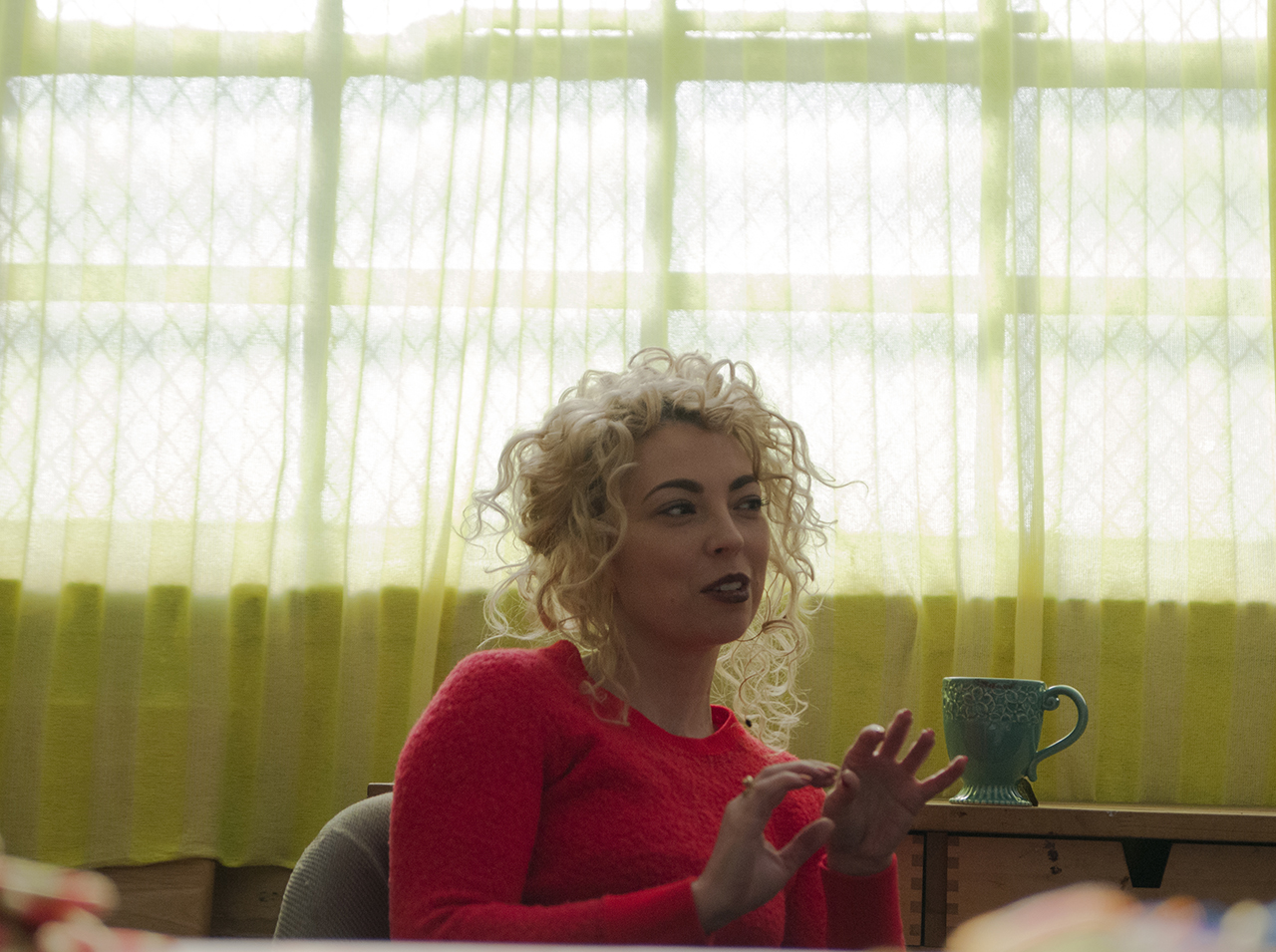
Appearing like the jumbled clothing stores from which Sam pulls inspiration, her studio contains large collections of yarn, thread, fabric, and sweaters of every color and pattern. Crafting geometric works out of her compilations of amorphic material, Sam occasionally adds hair to exemplify her practice’s position between sculpture and body.
I\W: What is your intent with the wearable pieces you create? Why do you feel like they need to be activated by the human body?
SJ: I think my pieces interacted with the body already, before I made the wearable works. I use forms that look like the body, or have a kind of tactile, interactive presence to them. I think it was a natural move to make them into something that is worn on or around the body. I ran into some problems, like knowing what the people should do once inside of the forms. I didn’t know if they should move around, or if they should stay completely still. I ended up building structures for the pieces to go on and then had people sit inside of them, like human sculptures. The presentation was strange because since there were live bodies involved. There was an expectation that some action was going to happen, and then it didn’t. I had never tried anything like that before. I have taught fashion construction classes and I have made garments before, but I never figured out how they could be a part of my practice.
Your practice also involves the fallibility of the human body. How does that work with your less body-oriented pieces?
I think all of my work is body-oriented. For this last show I did at 65 Grand, Bleed, I created a bunch of pieces that were much more geometric, but also had bodily moments. In one of the pieces, I created this really geometric form that had human hair growing from the seams. It has moments of being human, except that it is extremely rigid and has a weird, synthetic color. When I think of things being bodily, I am more interested in how a viewer is interacting with art. When I am looking at a piece of art, I am feeling as if I am looking at a being or a mirror. I can’t help but think of it as an anthropomorphic object. Even if that piece doesn’t directly reference the body, it is kind of how I view my work: as my friends or my little buddies that I make. I think the fallibility aspect is really about a piece that is a mutation of the body or a proliferation or a riffing of what bodies look like—imagined bodies, dream bodies, nightmare bodies. Also with the materials I’m interested in, it is always rigid and movable and perfect and imperfect and funny and fucked up.
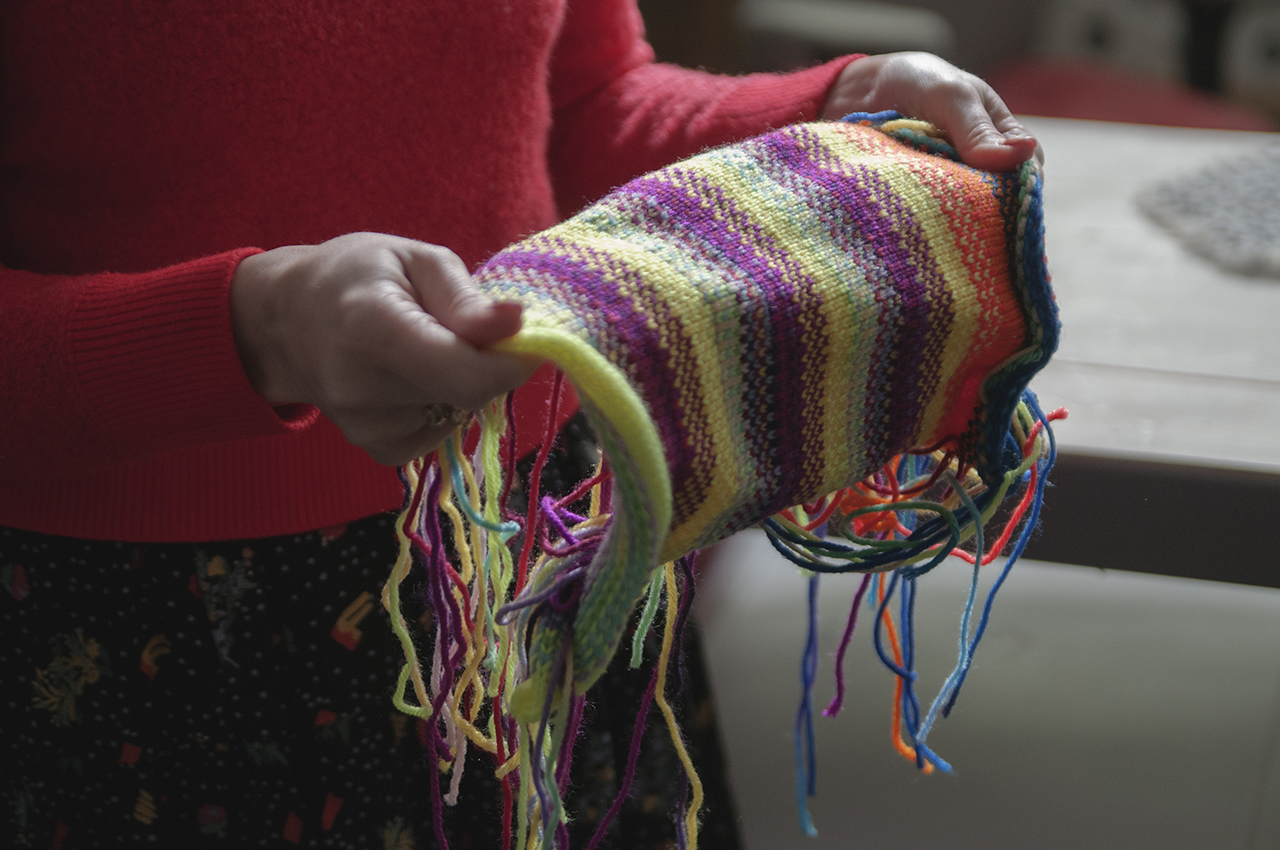
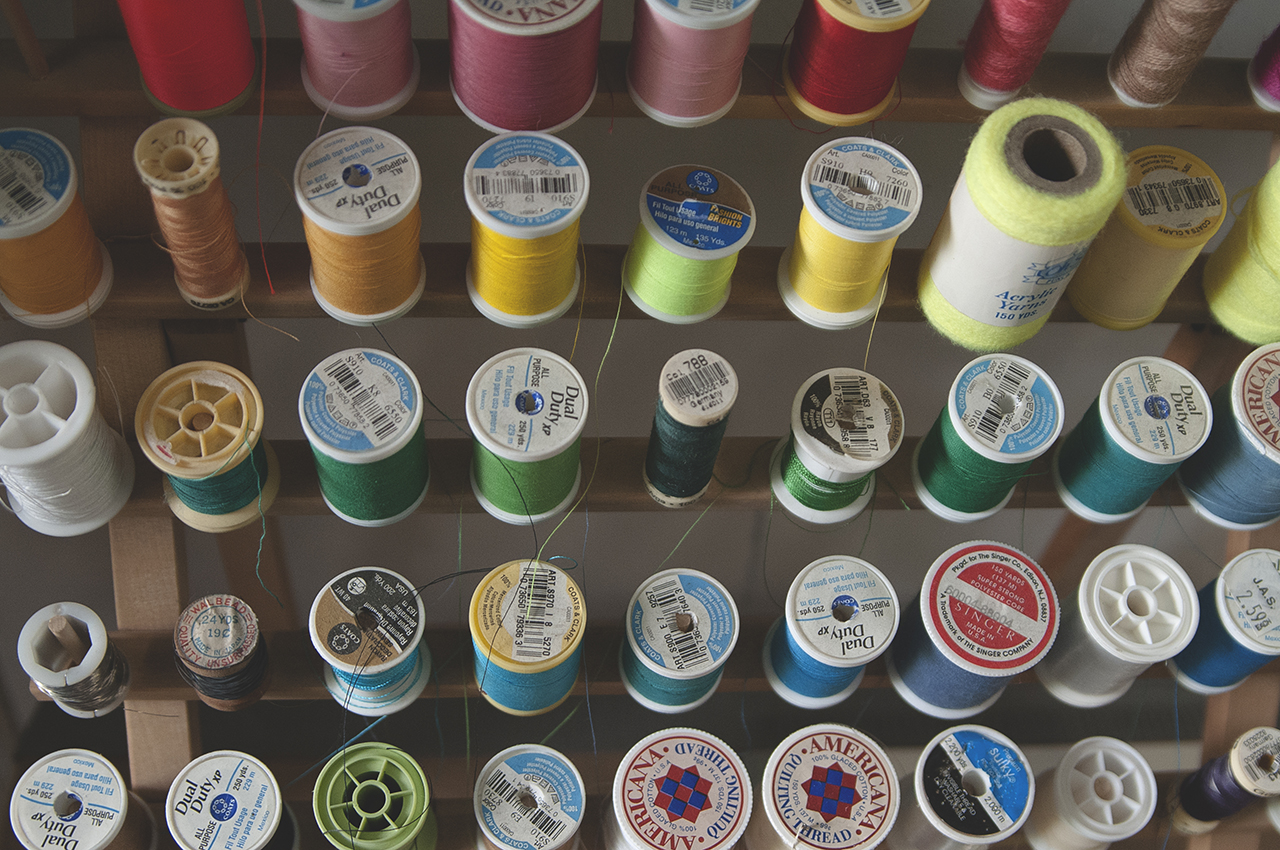
Is that why you started incorporating human hair into your pieces?
I am really interested in that tension, especially in combination with the geometry. I like to make the pieces around my size so they have a human-ish, or me-ish presence. In a gallery setting they take on the personality of another guest at the gallery. I am interested in a “Sam scale” for the pieces. It totally goes along with the idea of trying to make them humanesque. They are like the wearable pieces where there is this expectation that is not being met. I could put googly eyes on them jokingly, but instead I want to spend time in this weird place between body and geometry, sculpture and person. I’m really caught up in materiality and human hair just has so many unique associations and meanings.
Why do you have such an attraction to colors that you consider “toxic” in your work?
The colors go along with this element of futurism or cyborgism in my work. It is interesting because you wouldn’t naturally associate a cyborg with yarn or fabric, but they are really closely related. A fabric is a structure that can be built. The knitting machine that I use to make many of these things is like a really primitive computer with 0’s and 1’s. It is math and geometry. When you think about it, fabric is often seen as this amorphic, organic thing, but like many organisms, it is actually really predictable, structural, and cellular. The “toxicity” of the color choices that I make are really about an interest in the wonderfully synthetic pop culture that I find myself amongst. I’m not sure why I feel like I’m living in the future amongst cyborgs, but I often do.
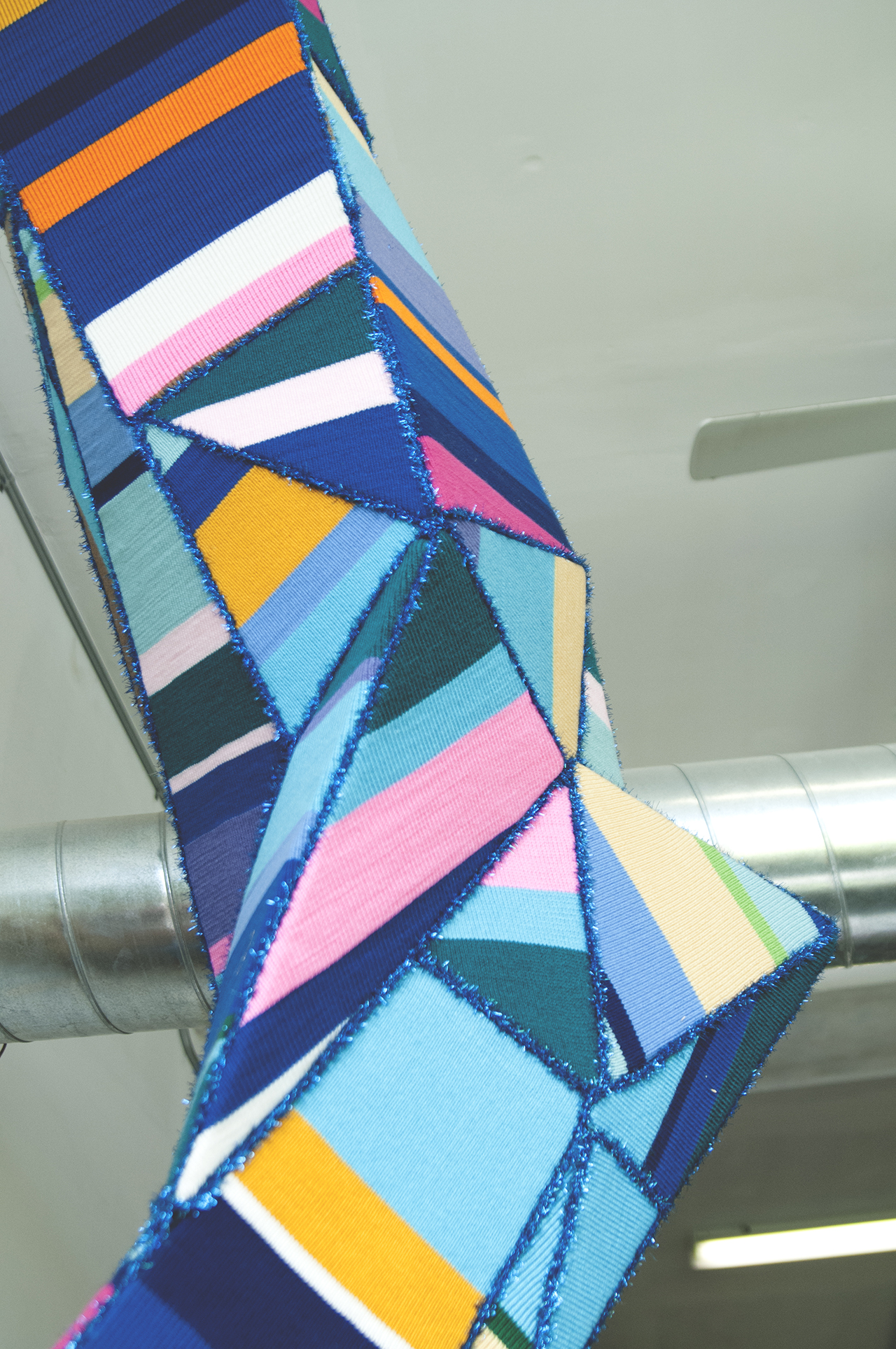
What is the purpose of the included cast-offs that you use in your work?
In this last show I used a lot of materials from junior clothing stores like Forever21 because I have been interested lately in the idea of knock off, knock off, knock off designs that makes up a huge part of the mass-produced clothing industry. Forever21 is a perfect example because it is meant to be super on trend and in the moment. The clothes are meant to be a symbol or reflection of something cultural that is happening right now, so the process of trying to copy designer clothing has to happen really quickly and thus pretty poorly. I really wanted to try to use these perversions of original designs and see how they could be incorporated into the work. I did a lot of pieces that were made from found Forever21 clothing. I am really enticed by the idea of trend, especially when it comes to color. The idea that a color can be a trend is very strange and it seems as though it should say something about our particular pop cultural moment. I’m not sure what that is, but over time these color trends are bound to tell us some kind of story. I love going into junior’s clothing stores and I take lots of pictures of the way that things are arranged and merchandized. There are so many clothes that are just scattered and combined. It is a beautiful accidental world of pattern and color. I just get inspired by the accidents. I make a lot of my own fabric also, and I am trying to replicate these things recently.
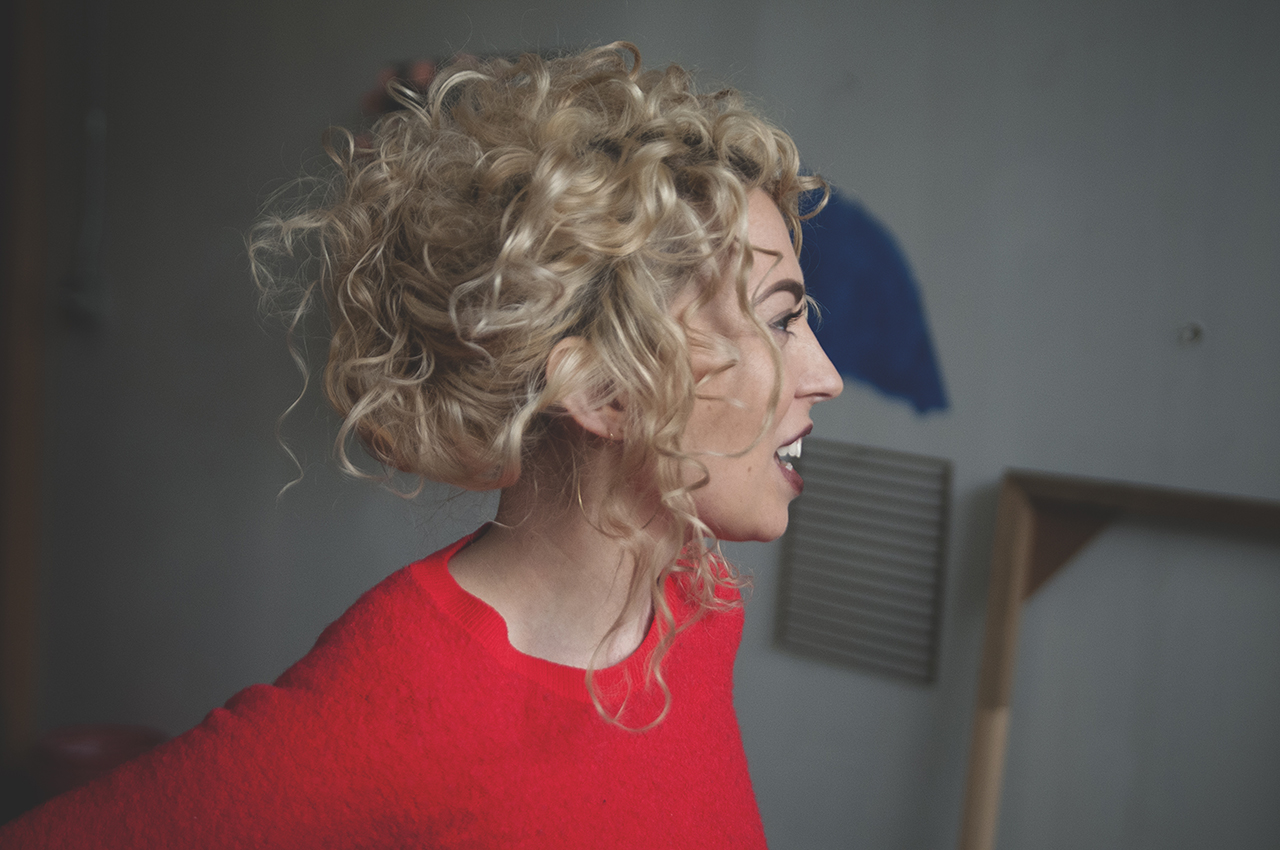
I read that your family has a history of weaving and textile work. Did this influence your own practice?
My mom’s family came to the states from Portugal and England and some of them were weavers in the textile mills in Lowell, Massachusetts during The Industrial Revolution, and my grandpa was a loom fixer as a child. However, I didn’t grow up knowing much about that. I learned about it later in life. My mom is a fantastic knitter as a hobby, but I can’t knit anywhere near the way that she can. I think my interest in fabric started because I was always really petite for my age, so when I was a kid I was always sewing my own clothes and altering things for myself and I just got better at sewing. I went to school for drawing and painting and at some point they came together. I think that is more where my interest in fabric came in. Additionally, I am into fashion and collecting clothes and thrifting. I think that clothing is deservedly important to people and our presentations of self. It is often minimized as something vapid or materialistic. I spend a lot of time working on the collections I have because they influence the work a lot. One day a week I will go search around to a few of my thrift favorites. I have a few places I will go in a row. I do a quick search. When I see something that has potential for the work, I know it immediately. I don’t always find something.
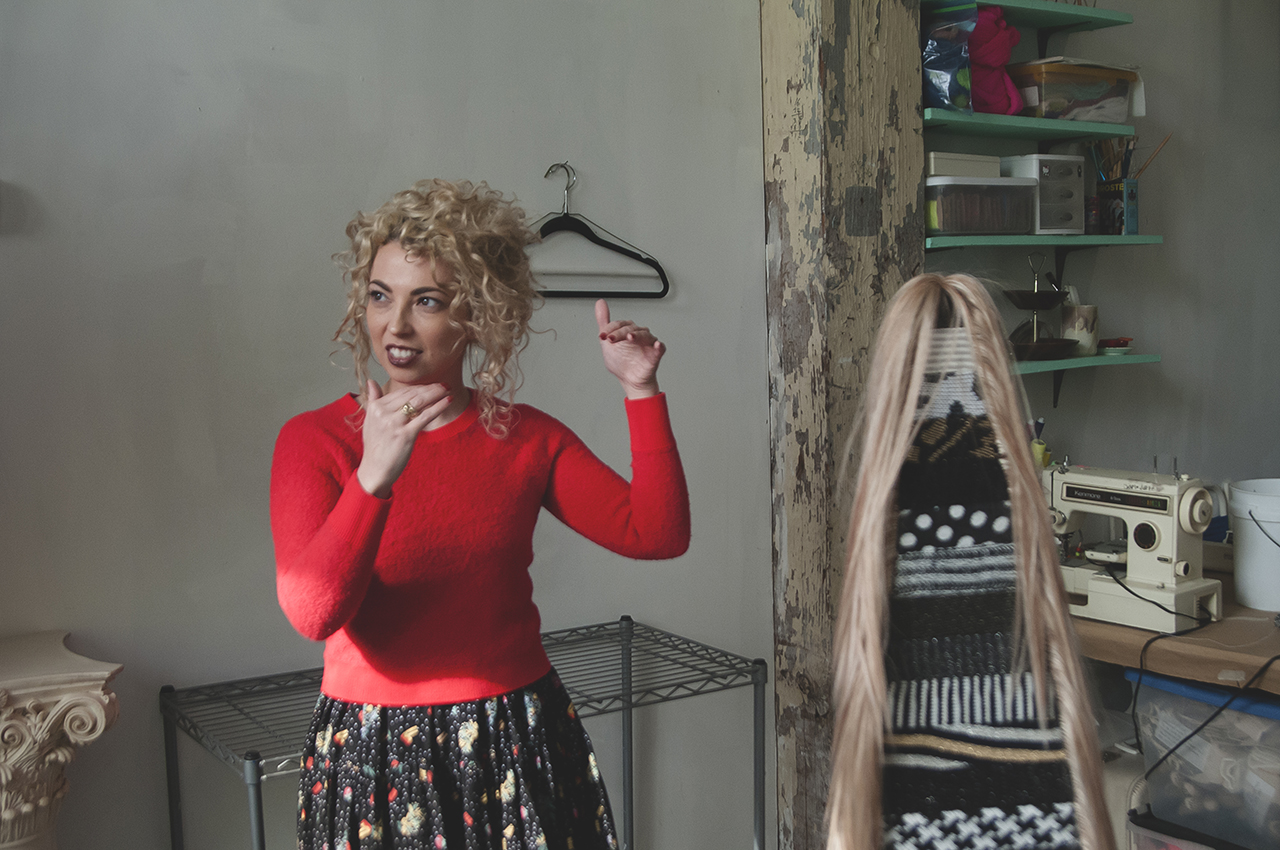

What types of materials have you been making lately?
Lately, I have been working with variegated yarn, yarns that are dyed differently throughout the piece of yarn and then combining those with other colors of variegated yarn so you get this pattern where every stitch is a bit different. It is a game of chance using those too because each one is dyed a bit differently. When you think something is going to happen, it doesn’t necessarily, but the outcome is always something compelling to me. One thing I am trying to do is create more sculptural things with the knitting machine. I’m using a laser cutter to create 3D or 2.5D forms and then covering them with different fabrics. Then I put the pieces back together like a puzzle. I watch YouTube videos to learn new knitting machine techniques and am using Illustrator and Photoshop more lately to “design” the works a bit more. Of course, things always change drastically once I actually start manipulating materials with my hands.
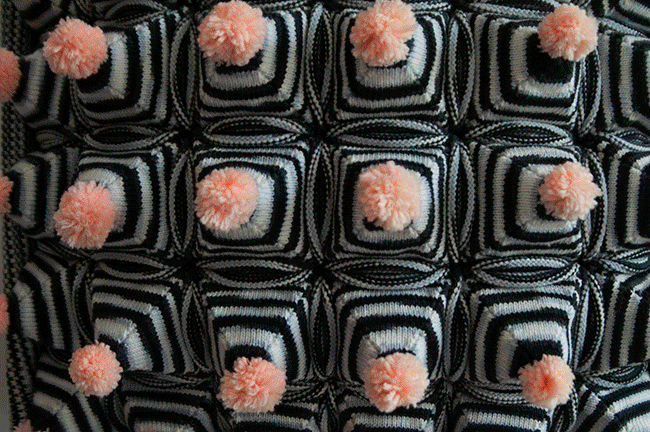
How did studying painting influence your textile work?
I think it influences my work in the fact that my pieces often end up on the wall, but I don’t use paint very often lately. I have to think about painting all the time as I studied it and I’m teaching painting courses currently. However, paint as a material has a narrative that I find difficult to wrestle with. It has been historically used in a way that I find quite macho and in my estimation has largely been about illusionistic trickery, virtuosity, and demonstrating a variety of discriminatory social hierarchies. There are many talented, contemporary painters who find ways to overcome this type of baggage, but I find it much easier to make work with the things that are just around: things that a majority of people have quite intimate relationships with. Fabric is such a perfect example since most humans are almost never not touching it. We wrap ourselves up in it every night, we wear it daily, we are swaddled in it the moment we are born, we make love amongst it, and are covered in it when we die. There’s no mystery about it. It’s just so relevant to our most banal experiences! With that being said, I think the traditions of painting are difficult for many artists to avoid since they are traditionally so exalted and continue to be within art institutions. Even if an artist’s work is in a way positioned against painting, it’s still there.


